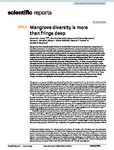Mangrove diversity is more than fringe deep
| dc.contributor.author | Canty, SWJ | |
| dc.contributor.author | Kennedy, JP | |
| dc.contributor.author | Fox, G | |
| dc.contributor.author | Matterson, K | |
| dc.contributor.author | González, VL | |
| dc.contributor.author | Núñez-Vallecillo, ML | |
| dc.contributor.author | Preziosi, Richard | |
| dc.contributor.author | Rowntree, Jennifer | |
| dc.date.accessioned | 2022-02-04T11:50:31Z | |
| dc.date.available | 2022-02-04T11:50:31Z | |
| dc.date.issued | 2022-12 | |
| dc.identifier.issn | 2045-2322 | |
| dc.identifier.issn | 2045-2322 | |
| dc.identifier.other | 1695 | |
| dc.identifier.uri | http://hdl.handle.net/10026.1/18645 | |
| dc.description.abstract |
<jats:title>Abstract</jats:title><jats:p>Mangroves form coastal tropical forests in the intertidal zone and are an important component of shoreline protection. In comparison to other tropical forests, mangrove stands are thought to have relatively low genetic diversity with population genetic structure gradually increasing with distance along a coastline. We conducted genetic analyses of mangrove forests across a range of spatial scales; within a 400 m<jats:sup>2</jats:sup> parcel comprising 181 <jats:italic>Rhizophora mangle</jats:italic> (red mangrove) trees, and across four sites ranging from 6–115 km apart in Honduras. In total, we successfully genotyped 269 <jats:italic>R. mangle</jats:italic> trees, using a panel of 677 SNPs developed with 2b-RAD methodology. Within the 400 m<jats:sup>2</jats:sup> parcel, we found two distinct clusters with high levels of genetic differentiation (F<jats:sub><jats:italic>ST</jats:italic></jats:sub> = 0.355), corresponding to trees primarily located on the seaward fringe and trees growing deeper into the forest. In contrast, there was limited genetic differentiation (F<jats:sub><jats:italic>ST</jats:italic></jats:sub> = 0.027–0.105) across the sites at a larger scale, which had been predominantly sampled along the seaward fringe. Within the 400 m<jats:sup>2</jats:sup> parcel, the cluster closest to the seaward fringe exhibited low genetic differentiation (F<jats:sub><jats:italic>ST</jats:italic></jats:sub> = 0.014–0.043) with the other Honduran sites, but the cluster further into the forest was highly differentiated from them (F<jats:sub><jats:italic>ST</jats:italic></jats:sub> = 0.326–0.414). These findings contradict the perception that genetic structure within mangroves forests occurs mainly along a coastline and highlights that there is greater genetic structure at fine spatial scales.</jats:p> | |
| dc.format.extent | 1695- | |
| dc.format.medium | Electronic | |
| dc.language | en | |
| dc.language.iso | en | |
| dc.publisher | Springer Science and Business Media LLC | |
| dc.title | Mangrove diversity is more than fringe deep | |
| dc.type | journal-article | |
| dc.type | Journal Article | |
| dc.type | Research Support, Non-U.S. Gov't | |
| plymouth.author-url | https://www.webofscience.com/api/gateway?GWVersion=2&SrcApp=PARTNER_APP&SrcAuth=LinksAMR&KeyUT=WOS:000749732100002&DestLinkType=FullRecord&DestApp=ALL_WOS&UsrCustomerID=11bb513d99f797142bcfeffcc58ea008 | |
| plymouth.issue | 1 | |
| plymouth.volume | 12 | |
| plymouth.publication-status | Published online | |
| plymouth.journal | Scientific Reports | |
| dc.identifier.doi | 10.1038/s41598-022-05847-y | |
| plymouth.organisational-group | /Plymouth | |
| plymouth.organisational-group | /Plymouth/Faculty of Science and Engineering | |
| plymouth.organisational-group | /Plymouth/Faculty of Science and Engineering/School of Biological and Marine Sciences | |
| plymouth.organisational-group | /Plymouth/REF 2021 Researchers by UoA | |
| plymouth.organisational-group | /Plymouth/REF 2021 Researchers by UoA/UoA07 Earth Systems and Environmental Sciences | |
| plymouth.organisational-group | /Plymouth/Users by role | |
| plymouth.organisational-group | /Plymouth/Users by role/Academics | |
| dc.publisher.place | England | |
| dcterms.dateAccepted | 2022-02-17 | |
| dc.rights.embargodate | 2022-2-5 | |
| dc.identifier.eissn | 2045-2322 | |
| dc.rights.embargoperiod | Not known | |
| rioxxterms.versionofrecord | 10.1038/s41598-022-05847-y | |
| rioxxterms.licenseref.uri | http://www.rioxx.net/licenses/all-rights-reserved | |
| rioxxterms.licenseref.startdate | 2022-12 | |
| rioxxterms.type | Journal Article/Review |


